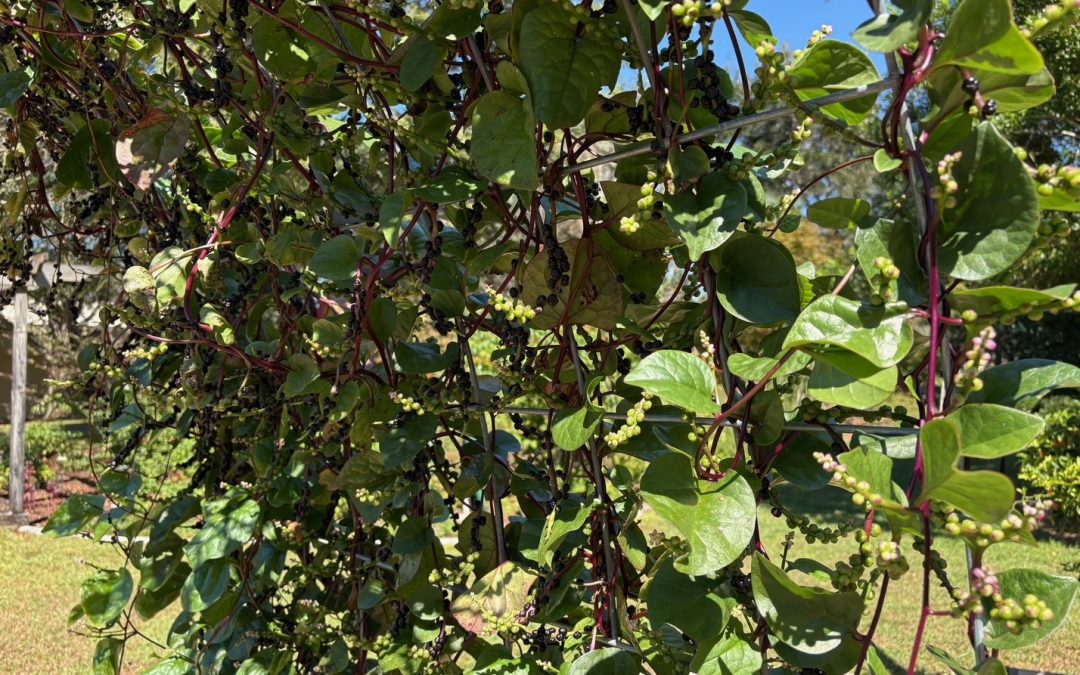
by Beth Bolles | Oct 17, 2025
Saving seeds is a wonderful garden activity that gives us both a sense of pride in our gardening skills and helps us save a few dollars on new seeds.
Malabar spinach is one of our heat loving vines that grows well until frost and produces abundant seed. If you are looking for a leafy green spinach substitute, Malabar spinach does very well in the summer garden. We had a late start on planting our Malabar spinach in the Escambia Extension garden so the seeds are now ripening. This is the perfect plant for saving seeds.
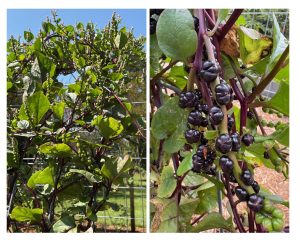
Vines growing along with mature fruit. Photos by Beth Bolles UF IFAS Extension Escambia County.
Malabar spinach has plenty of fruit for you to save seeds for yourself and friends. When mature, fruit will be dark purple and you may easily pull the fruit off stems into a small container. This is definitely a practice that requires gloves unless you want to have your hands stained purple for a while.
Your next step is to lightly press on the fruit while running them under water. Have a strainer underneath to catch the fruit. You are just trying to loosen some of the pulp, not remove every bit. Fill a small jar 3/4ths with water and then add your fruit. Let this sit on a counter for a few days. You may change out the water as needed. This is the step that loosens the remaining pulp from around the seeds.
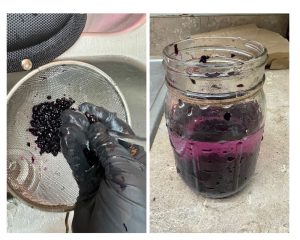
Loosening pulp from seeds and then soaking in water. Photos by Beth Bolles, UF IFAS Extension Escambia County.
After several days in the jar, pour the jar liquid through a strainer and wash over it with clean water. This removes the final bits of pulp. Place a paper towel or cloth on the counter and lay out your cleaned seeds. They will need to air dry for a couple of days. Keep seeds away from a heat source and out of the sun.
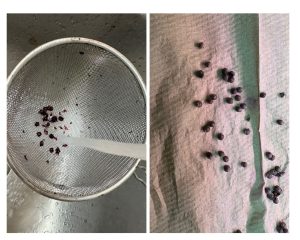
Final rinse of seeds and drying on towel. Photos by Beth Bolles, UF IFAS Extension Escambia County.
Once dry, you are ready to package your seeds for next season’s planting or gifts for friends. You may use a paper envelope or small plastic bag. You may also add seeds to a jar, close it tightly, and put in the refrigerator. Label your package with the plant and date because you will not remember those details later.
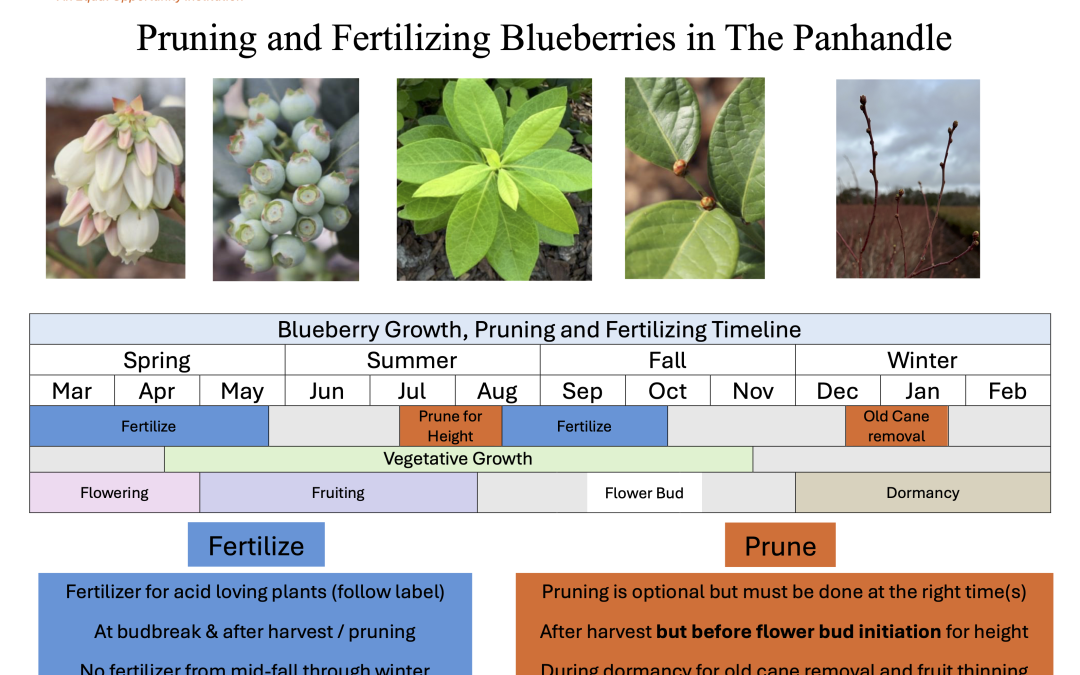
by Lauren Goldsby | Jul 31, 2025

Blueberry flower buds are formed at the cane ends.
When, how, and if you prune your blueberries depends on your goals and how you want to manage your plants. Pruning is usually done to control plant height, open up the canopy, and remove older canes that are less productive. Blueberry canes form flower buds starting from the upper ends of the stems. As plants grow taller, the best berries develop higher and higher. Lower, shorter canes will still produce fruit, but the upper canopy can shade them, leading to fewer berries within easy picking height. Rabbiteye varieties common in the Panhandle can reach 20 feet (7 m) if left unpruned. Some gardeners like leaving the upper berries for birds while harvesting the lower fruit for themselves, while others prefer to prune plants shorter to keep berries within easy reach.
Blueberry plants can be pruned at two main times of year:
After harvest (summer): This is the time to reduce plant height, but it must be done soon after the last berries are picked and before fall, when flower buds form inside the stems. If you wait too long, you risk cutting off next season’s flowers and losing fruit. After summer pruning, it’s a good time to apply an acid-loving plant fertilizer to encourage new growth.
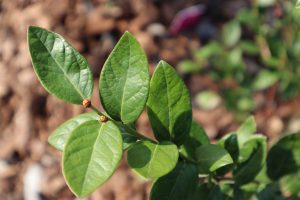
Once buds are visible, it’s too late to prune for height without losing berries.
During dormancy (winter): In winter, you can remove dead, damaged, or old unproductive canes to open up the canopy and allow for new growth. Avoid removing more than 30% of the total canes in a single year. Winter is also when fruit thinning can be done. If there are too many buds on the plant, the berries may stay small. By selectively removing canes, the plant can produce fewer but larger berries.
Pruning can be an important management tool, but it isn’t mandatory. If you choose to prune, make sure to do it at the right time for your goal- whether it’s controlling height, encouraging bigger berries, or simply refreshing older plants. See the chart below for a seasonal guide to pruning and fertilizing blueberries in the Panhandle. Pruning and Fertilizing Handout Download
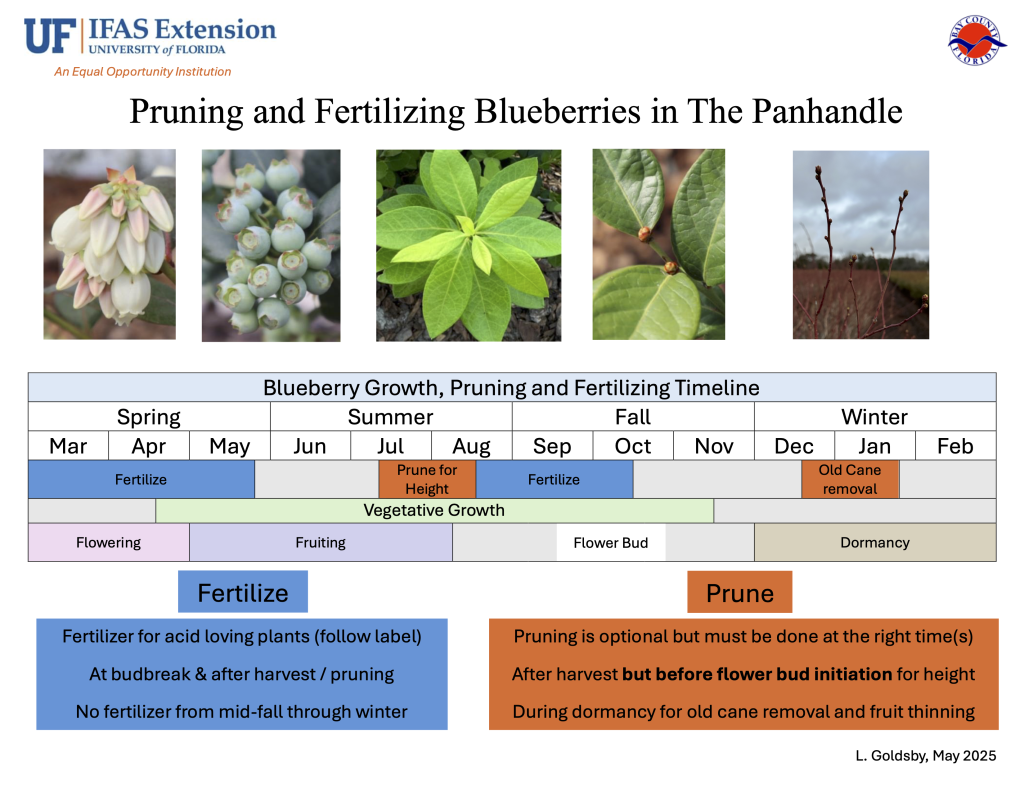
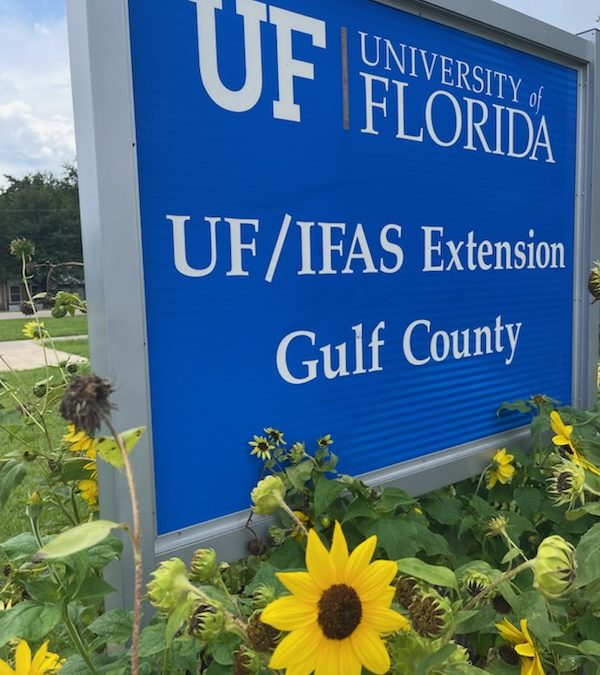
by Ray Bodrey | Jul 20, 2025
Sunflowers, Helianthus spp., are a great choice for gardeners who are looking for some cheerful color in their landscape. Here in Florida, we have the main ingredient for success, lots of sunshine!

Skyscraper Sunflower. Credit: Ray Bodrey, UF/IFAS Extension.
Sunflowers are short-lived annuals. A good average time between planting and bloom is roughly 65 days. You can typically plant sunflowers in Florida beginning in late winter until early fall. Only the coldest months are the issue, and for most years that’s only a couple of months for us. Sunflowers can be planted almost anywhere there is full sun. The major selling point to plant sunflowers is of course the impressive blooms (figure 1). These yellow to sometimes orange or red petaled flowers develop a central seed disc, with most varieties having approximately an 8” diameter in growth.
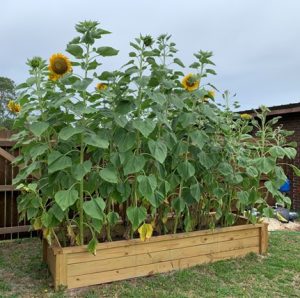
Skyscraper sunflowers planted in close pattern. Credit: Ray Bodrey, UF/IFAS Extension.
As for planting, you may choose to plant narrow rows and close seed spacing in order to cull less preforming plants later. A final row and seed spacing of 2’-3’ is recommended for full height and development of most varieties. However, you may choose to plant in a bed, using a close pattern as seen in figure 2. In any event, sunflowers are easy to propagate by seed and are very low maintenance. However, powdery mildew and spittle bugs can be a nuisance. A general garden fungicide and insecticide will help if problems occur.
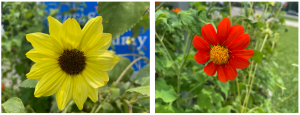
Sunflowers, Helianthus spp. Credit: Ray Bodrey, UF/IFAS Extension.
Sunflowers are available in many varieties, which consists of different color blooms and plant sizes. These sizes range from dwarf (1’-3’) to tall (10’-15’) varieties (figure 2). You may wish to stake taller varieties at some point, as some plants will tend to lean with no wind break in place. Here’s a few gardening variety common names to look for: sunbright, sonja, sunrich lemon or orange and autumn beauty. Seed companies also have mixes available in packets. For tall plants, mammoth or skyscraper varieties exist.
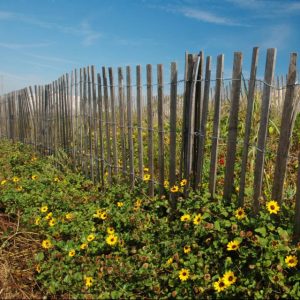
Beach sunflower. Credit: Ralph Mitchell, UF/IFAS Extension.
If you are fond of the sunflower bloom and looking for a groundcover, there are a couple of native perennials that fit this category. Beach sunflower, Helianthus debilis or swamp sunflower, Helianthus angustifolius, are groundcovers/ornamentals for landscapes and thrive in dry, hot climates and in a range of soil types. They also are great pollinator attractors.
For more information, contact your local county extension office. Happy Gardening!
Supporting information for this article and links to other publications can be found at the UF/IFAS Gardening Solutions website: https://gardeningsolutions.ifas.ufl.edu/plants/ornamentals/sunflowers.html
UF/IFAS Extension is an Equal Opportunity Institution.

by Beth Bolles | Apr 3, 2025
The Northwest District Agents discussed foodscaping by answering questions submitted by program participants. Included are the panelist’s answers along with supporting publications for the questions. You may view the session on YouTube at https://www.youtube.com/watch?v=wEMXmaZqRTU
- Suggestions for only 4-6 hours of sunlight in an oak tree hammock.
Bell peppers can grow in some shade in containers or in the ground. Leafy lettuces for the cooler months.
Publication: Peppers in the Shade, https://edis.ifas.ufl.edu/publication/HS368
- What is the best citrus for North Florida?
Satsuma would be a cold hardy selection with delicious fruit. Owari and Brown Select grow well in Panhandle. Tangerine and Meyer lemon is intermediate in cold hardiness. Start fruit in about a year but remove those early to but energy into the tree. Look for harvesting fruit in about 3-5 years. Look at our citrus publication for citrus fertilization with a fertilizer that contains zinc and iron.
Soil test to match plants with the right locations.
Publication: The Satsuma Mandarin, https://edis.ifas.ufl.edu/publication/CH116
- What fruit trees can I grow?
Choose a variety adapted to our area. Peaches, pears, plums, some citrus, Pineapple guava, Loquat. Choose ones with chill hours for our area. Look at Auburn and Georgia selections rather than Florida selections which are more adapted to central and south Florida.
Publication: Dooryard Fruit Varieties, https://edis.ifas.ufl.edu/publication/MG248
- What about companion planting?
One plant will benefit another – attracts beneficials, provides chemicals for a purpose. Use a trap crop that attracts insects to catch them before they move to your desirable fruit.
Marigolds is an example of use around some edibles to reduce nematodes.
Publication: Companion Planting, What is It? https://nwdistrict.ifas.ufl.edu/hort/2023/02/21/companion-planting-what-is-it/
- I need to add soil to my native/food garden. What are considerations?
Sandy soils may need some amendments. Compost should be mixed in and not grow straight in compost. Maybe add ½ inch.
Soil test first so you don’t add too much nitrogen through amendments.
Publication: Soils and Fertilizers, https://sfyl.ifas.ufl.edu/lawn-and-garden/soil-and-fertilizer/
- I have 3-4 blueberry bushes and they are 2-4 years old and haven’t fruited. What is wrong?
Know the cultivar so you are sure they have a cross pollinator. Need the right conditions too. Blueberries set in the fall so if fall pruning, you may have cut off flowering structures. Soil pH is critical. Blueberries like acidic soil and they will struggle in higher pH soils.
Publication: Blueberry Gardener’s Guide, https://edis.ifas.ufl.edu/publication/MG359
- How do I grow lavender in the landscape?
Lavender likes low humidity and drier conditions. Soil should be well drained and plants need good air circulation. Maybe try Phenomenal lavender. Grow in a pot that is very well drained and don’t amend soil when planting in the ground. Prune as needed to open up plant.
Publication: Lavender, https://edis.ifas.ufl.edu/publication/FP337
- Which apple trees grow best in North Florida?
You can grow a tree but it does not produce well due to lack of proper chill hours. Try the Shell apple which is more adapted to north parts of the counties.
Our area may get 500-600 hours of chill generally.
Publication: Dooryard Fruit, https://edis.ifas.ufl.edu/publication/MG248
- What about edibles near saltwater?
Many edibles won’t like saltwater intrusion. Cowpeas, black eyed peas are the most salt tolerant. Some of the cuburbits (squash, pumpkin, zucchini, gourds) can tolerate some salt.
Grow some plants in a protected area or in containers. Consider some of the shrubby edibles that match the pH at the coastal sites.
Publication: Soil Salinity and Vegetables, https://sfyl.ifas.ufl.edu/media/sfylifasufledu/miami-dade/documents/disaster-preparation/post-hurricane-and-disaster/Soilsalinityinfodraft.pdf
- How to protect plant from insects without pesticides, including squirrels?
Reduce stressed by planting in the right spot and providing care. You will also have many diverse plantings in a foodscape to allow beneficial to help manage pest. Monitoring the garden is very important to catch problems early and physically remove. Consider safer options when pesticides are needed that are labeled for food crops.
Might use some screening for small mammals and fencing for large animals. Motion activated sprinklers and scare devices such as ribbon, foils. Chemical repellents that contain capsaicin.
Publication: Natural Products for Pest Control, https://edis.ifas.ufl.edu/publication/IN197
- Publication: Deterrents for Nuisance Wildlife, https://edis.ifas.ufl.edu/publication/UW371
- What are the most common vegetables for small spaces?
Some plants will need at least 12 inches of depth such as tomatoes. Lots for winter edibles do well in small spaces and containers. Consider a patio version of the plant. There are small selections of Pineapple guava and Pomegranate although they may produce smaller fruit.
- How easy is it to grow in containers?
You can grow in the ground with good soil and if you can work with plants on the ground.
Containers allow you to create the right soil environment easy. You do have to manage water carefully as the heat builds up.
Publication: Growing Vegetables in Containers, https://gardeningsolutions.ifas.ufl.edu/plants/edibles/vegetables/growing-vegetables-in-containers/
- What are the best tomatoes for the area?
Determinate and cherry will perform a little better. Choose early or mid producing plants to get fruit
Panelist’s favorites are:
Everglades and Sungold, Early Girl, Cherokee Purple is an heirloom
- What edibles can handle full sun?
Most fruit plants like sun since they are needing lots of energy. Water must be available when rainfall is lacking.
- Three fruit trees have not produced in 3 years. What do we need to do?
We really need to know what they are first. Do they need a plant for cross pollination? Are they flowering but not fruiting? How are they planted? Deep planting will cause a plant to struggle. Contact your Agent for more help.
- Will glyphosate residues from a fall application carry over to spring?
Chemicals are regulated extensively so follow the label directions for safety. There should not be residue issues with this pesticide.
Try to manage weeds with other techniques like mulches, handpulling, directed watering, soil solarization, etc.
Publication: Use of Glyphosate and Herbicide Alternatives for Weed Control in Florida Landscape Planting Beds, https://edis.ifas.ufl.edu/publication/ep580
- What are some native plants for foodscaping?
Blueberries, blackberries, Chickasaw plum, pecans, persimmons, Maypop, Mulberry.
Use native plants to attract animals such as beautyberry.
- Where can we find compost?
Cotton gin to get cotton gin trash will need to be composted first. Manure from equestrian centers or zoos. Make sure it is composted too.
Peanut processing facility.
Escambia County has bloom compost from ECUA.
- Note: Amended soil with compost can be flammable. Ash can benefit garden if needed. Test soil pH first so you don’t add too much.
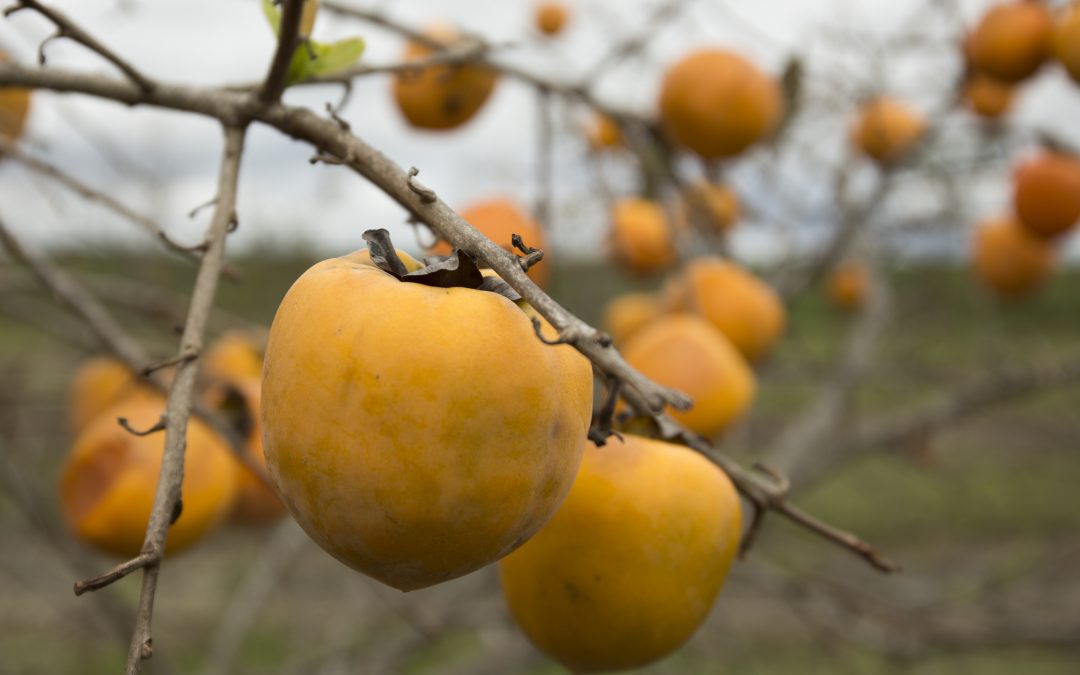
by Muhammad Shahid | Oct 17, 2024
Persimmon harvesting, ripening, and preservation strategies
Persimmons fruits are renowned for their delicious, sweet taste, making them incredibly tasty and nutritious. They are native to China but have spread worldwide, especially in temperate and subtropical climates. These fruits have been cultivated for thousands of years, primarily for their sweet flesh, which varies in texture from firm to custard-like, depending on the variety and level of ripeness. Persimmons are a rich source of vitamins, particularly vitamins A, C, and E. They also contain dietary fiber, which is beneficial for digestive health. They also have anti-inflammatory properties and reduce the risk of chronic diseases like heart disease and cancer.
Astringent vs non-astringent varieties
There are two main types of persimmons: the astringent and non-astringent varieties. Astringent persimmons, like Hachiya and Tanenashi, are high in tannins and must be fully ripened before consumption to avoid an unpleasant taste. The water-soluble tannins give the fruit astringency, making it inedible until it grows soft and ripe. Therefore, ripening for these varieties is essential to enable the tannins to disintegrate, allowing the fruit to taste as sweet and rich as it deserves. On the other hand, non-astringent persimmons, such as Fuyu and Jiro, are sweeter and can be consumed even when they are still firm. These varieties have low or no tannin content, and hence, they can be consumed raw and crispy without the dry mouth effect of other more stringent types (Figure 1).
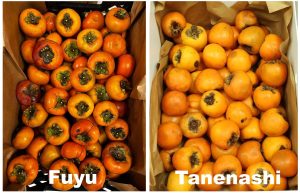
Japanese persimmon fruit: non-astringent variety ‘Fuyu’ (left) and astringent variety ‘Tanenashi’ (right).
Ripening and harvesting the persimmon
Determining the ripening of persimmons depends on the variety. Astringent varieties should be completely soft and jelly-like before they are harvested, while non-astringent varieties can be picked when they are still firm but have reached their full orange color. Persimmons are typically harvested by hand to avoid damaging the delicate fruit. Using pruning shears or scissors, cut the fruit off the tree, retaining a small part of the stem to prevent skin tearing. This method helps in prolonging the shelf life of the fruit.
Methods to speed up the ripening process
Cool temperatures: Keep persimmons cool and leave them in one layer on the countertop. They will ripen in several days to a week and become ready for consumption. The indicators include changes in skin color to deep orange, and the fruit feels almost like jelly when pressed on; it is prepared to eat. If parts of the fruit are slightly bruised or get spots, the fruit is still in the ripening process.
Keep persimmon fruit stored with high ethylene fruits: Ethylene is a natural plant hormone used to promote fruit ripening. You can quicken the ripening process, especially for astringent varieties, by harnessing the power of ethylene by placing the fruit in a brown bag with other fruits like apples or bananas that produce more ethylene. The enclosed space inside the bag retains the ethylene gas, enhancing the tannin deterioration in the persimmons. Use the following steps: Use a clean paper bag, place 3-4 persimmons with one apple or banana inside the bag, then close it and let it stay warm. The persimmons should be checked daily in order not to over ripen. They should soften in 2-3 days, depending on how hard they were.
Freezing: Freezing is another method to reduce astringency. Freeze the unripe astringent persimmons for about one day or until you feel they are already sufficiently chilled. When the fruit thaws, it will have softened greatly and will not be as astringent because the freezing helped eliminate tannins. This method does not allow the fruit to ripen in the usual sense of the word but can quickly turn the persimmons into a palatable state. When frozen, the fruit becomes soft, slightly brown, and tender, so this method would be better served if one wanted to use the persimmon for baking or making purees.
Preservation and storage
Preserving persimmons is key to enjoying their unique flavor and texture long after the harvest season. Persimmons, particularly astringent varieties, have a short shelf life once they ripen, so proper preservation strategies are essential for extending their usability and minimizing waste. Here are some practical methods for preserving persimmons:
- Persimmons should be stored at 50 degrees F (10 degrees C) for optimal preservation
- Use a transparent plastic bag with holes in it or a container with some holes on its surface. This will help prevent moisture accumulation, which, if left for some time, leads to mold growth on the container walls.
- Do not place persimmons in a tight, covered container, as they require ventilation to prevent mold growth.
- Use a mesh bag or a basket with a clean cloth that will allow air to circulate while at the same time keeping the fruit from developing bruises.
- The refrigerated persimmons can last up to 2 months. Examine them often for signs of spoilage, such as softness and mold formation.
- Frozen persimmons can be kept for up to 6 months.
Dr. Muhmmad A. Shahid, UF/IFAS NFREC, Assistant Professor of Horticulture
Dr. Shahid Iqbal, UF/IFAS NFREC, Postdoc Scholar, Horticulture Sciences
Dr. Muhammad Nadeem, UF/IFAS NFREC, Postdoc Scholar, Horticulture Sciences

by Molly Jameson | Sep 30, 2024
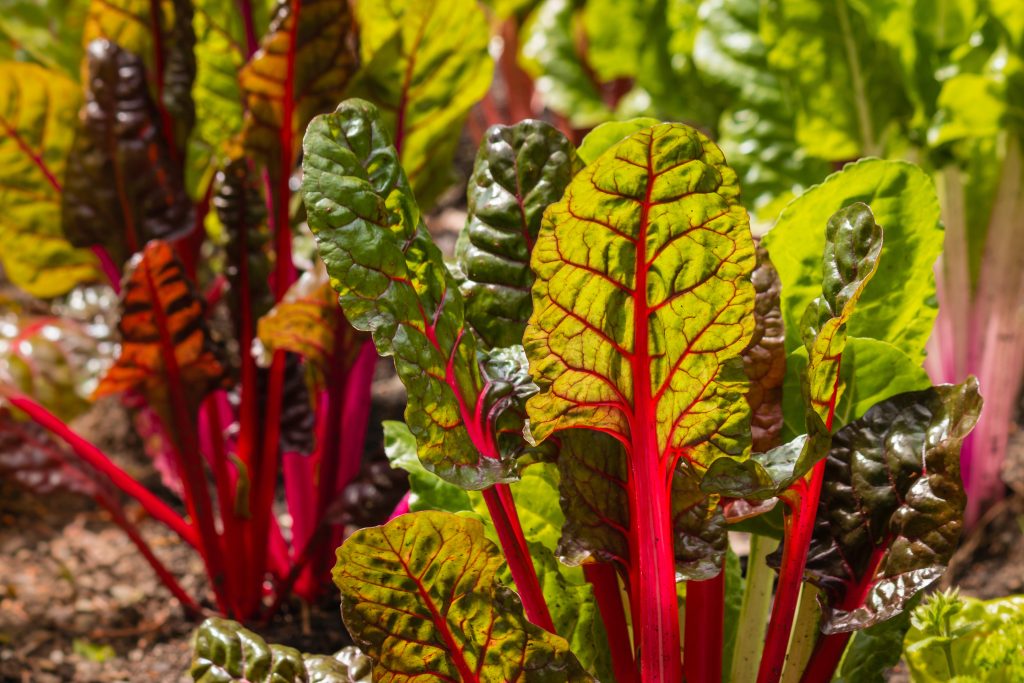
Swiss chard thrives in cooler weather, producing a continuous harvest of large, glossy, deep green leaves with colorful stems in shades of white, red, and yellow. Photo by Patrik Stedrak, Adobe Stock.
At first glance, beets and Swiss chard might seem like entirely different plants. Beets are known for their edible, bulbous root, while Swiss chard is grown for its large, leafy greens and colorful stems. However, both belong to the same species, Beta vulgaris, in the Amaranthaceae family, and their differences are the result of selective breeding over time.
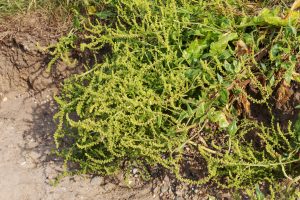
Wild sea beet (Beta vulgaris subsp. maritima), native to Mediterranean and coastal European regions, is the ancestor of cultivated beets and Swiss chard. Photo by Thorsten Schier, Adobe Stock.
Both beets and Swiss chard originate from the wild sea beet (Beta vulgaris subsp. maritima), a plant native to Mediterranean and coastal European regions. Ancient civilizations, such as the Greeks and Romans, bred beets for their enlarged roots, which eventually became the garden beets we know today. Despite its name, Swiss chard isn’t from Switzerland – it was also cultivated in the Mediterranean, bred for its nutritious leaves and stems. The “Swiss” name was added in the 19th century by seed catalog publishers to distinguish it from French spinach varieties.
Both beets and Swiss chard are highly nutritious. Beets, which range in color from deep red to golden yellow, are rich in vitamin C, folate (B9), and essential minerals like manganese, potassium, magnesium, and iron. They contain betalains, antioxidants with strong anti-inflammatory properties, and are a great source of fiber and nitrates, supporting digestion and heart health. Beets can be cooked in a variety of ways, offering a sweet, earthy flavor that intensifies when roasted. They can also be boiled, steamed, or eaten raw in salads, pairing well with tangy ingredients like citrus and goat cheese.
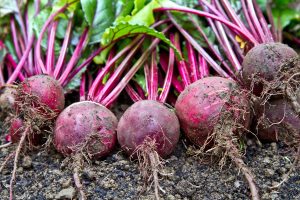
Beets can be grown in the fall and winter in the Panhandle, yielding round, bulbous roots with a sweet flavor and earthy aroma. Photo by Clickmanis, Adobe Stock.
Swiss chard, with its large, flavorful leaves and vibrant stalks in red, yellow, and white, is packed with vitamins A, C, and K, as well as minerals like magnesium, potassium, iron, and calcium. It also contains antioxidants like beta-carotene, lutein, and zeaxanthin, which support eye health and combat oxidative stress. Its high levels of potassium aid in electrolyte balance and heart health, while vitamin K and calcium contribute to strong bones. Swiss chard can be sautéed, added to soups, or eaten raw in salads, with both the leaves and stems being edible.
Essentially, beets and Swiss chard are different forms of the same plant, bred for either the root or the leaves. This explains why beet greens are similar in flavor and texture to Swiss chard, though beet greens are usually smaller and more delicate. Beets provide the advantage of both edible roots and greens, while Swiss chard offers vibrant, nutritious leaves that can be harvested throughout the season. Both crops thrive in cooler weather, making them ideal for fall and winter planting in the Florida Panhandle.




















